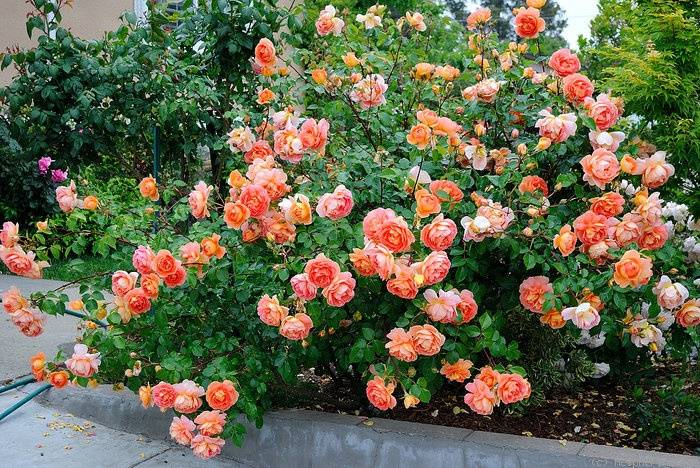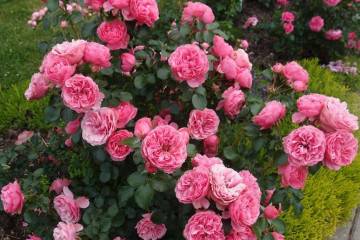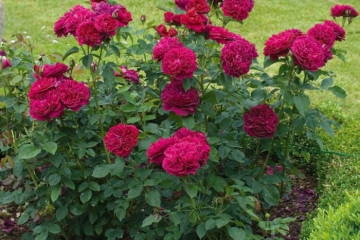Rose Pat Austin (Pat Austin) - variety description
Content:
Rose Pat Austin is one of the best creations of the famous breeder David Austin, the "father" of many different varieties of roses. Its petals are painted in copper, coral and amber tones, which greatly distinguishes this flower from English roses with the usual pastel color. For her beauty and aroma, Pat Austin has received numerous awards at prestigious international exhibitions.
Rose Pat Austin (Pat Austin) - what kind of variety, history of creation
The variety was created in 1995. Austin dedicated this wonderful piece to his wife. For breeding, a rose with a bright yellow flowering Graham Thomas and an apricot variety with pink blotches Abraham Derby were used.
Description of the rose:
- sprawling bush, about 120 cm high, about 1 m in diameter;
- shoots are thin and weak, they can not always keep on themselves a large number of lush buds;
- flowers are collected in a brush. Sometimes it can consist of 5-7 buds, but usually there are 3;
- flower size - from 8 to 12 cm, depending on the care of the rose;
- semi-double and double petals;
- a bowl-shaped bud consists of about 5-60 petals, which are mostly bent inward, the outer ones are wide open.
- on the inside, the petals have a bright copper hue, as they burn out, they acquire a coral color.
Advantages and disadvantages of the variety
The English variety Pat Austin is in great demand among gardeners due to its characteristics:
- delicate, unobtrusive aroma;
- doubleness of the flower;
- shade tolerance;
- long flowering in several stages;
- frost resistance.
Rose Austin Pat Austin has disadvantages:
- average immunity;
- heat intolerance;
- fear of rain;
- difficulty in reproduction.
Use in landscape design
The variety is ideal for decorating hedges.
Bushes with beautiful and lush flowering can be combined with other plants, putting Austin in the foreground.
Growing a flower in the open field
Planting a rose is not difficult, but still some rules must be followed. Planting is carried out only with purchased seedlings. This can be done in the spring or fall. The root system of seedlings is cleaned of dirt before planting, weak or damaged roots are removed. The rose is not demanding to the composition of the soil. The ideal soil is slightly acidic, with the addition of organic matter.
Austin loves well-lit areas, with a slope of no more than 10%. If the bushes are planted on the south side, they need to create shade by surrounding them with tall trees and shrubs.
Planting procedure step by step:
Recommended hole sizes - if loamy soil, depth from 40 to 50 cm, problematic or clayey soils - from 60 to 70 cm.
- Pits are dug in loamy soil with a depth of 40-50 cm, in problematic or clayey soil - 60-70 cm.
- Water is poured into the prepared hole.
- When the liquid is absorbed, soil is poured into the hole with the addition of peat, humus and a small amount of sand.
- The seedling is set in the hole.
- Its roots must be spread and covered with soil.
- The seedling is watered abundantly. Water consumption - at least 10 liters of water for each bush.
- After planting, the bushes need to be spud.
Plant care
Austin is a pretty demanding rose. But it is not necessary to water it often, in the summer it is enough once a week. Water consumption for each bush is at least 15 liters.
The Austin variety is very fond of foliar feeding. You can spray a rose with nutritious mixtures no more than 2 times a month.
Fertilizer use scheme:
- spring - nitrogen remedies;
- budding period - complex mineral fertilizers;
- after the first wave of flowering - mineral dressing;
- early autumn - phosphorus-potassium supplement.
Pruning and replanting
The transplant is carried out in the fall. Sanitary and formative pruning - in spring and autumn. Weak and damaged shoots are removed.
Features of wintering a flower
For the winter, the bush must be protected by covering it with spruce branches. In regions with harsh winters, a frame is made around the rose, which is closed with non-woven material or agrofiber.
Blooming rose
Abundant flowering begins in June and, with proper care, can last until the first frost. The bush wakes up at the end of March, the dormant period begins at the end of October.
During the flowering period, watering increases, mineral fertilizers are used. In the resting stage, sanitary or formative pruning is carried out. Withering buds must be removed immediately.
What to do if it does not bloom
The reasons for the lack of flowering are improper care of the rose. This is insufficient or excessive watering, low soil fertility, improper pruning.
Flower propagation
Independent reproduction is extremely difficult. Although grafting is considered a fairly effective method, cuttings of this rose rarely take root.
To prepare the cuttings, the woody shoot is cut off. It is cut into several pieces approximately 15 cm long. Each cutting should have at least 2 buds. The cut under the lower kidney is oblique, above the upper one - straight.
The cuttings are dipped in a growth stimulator for several hours, after which they are planted in the ground. In the spring, when the cuttings are rooted, they can be transplanted to a permanent place.
Diseases, pests and ways to control them
The rose can get sick with powdery mildew, rust, black spot. Treatment - removal of damaged parts, treatment of bushes with fungicides. Insect pests - aphids, bear, leafworm, spider mite. You can get rid of them by spraying roses with soapy water or insecticides.
Rose Pat Austin, although a rather whimsical flower, prone to diseases, but for the work and time spent by the gardener in caring for him, gratitude will certainly follow - abundant, very beautiful flowering until late autumn.



















